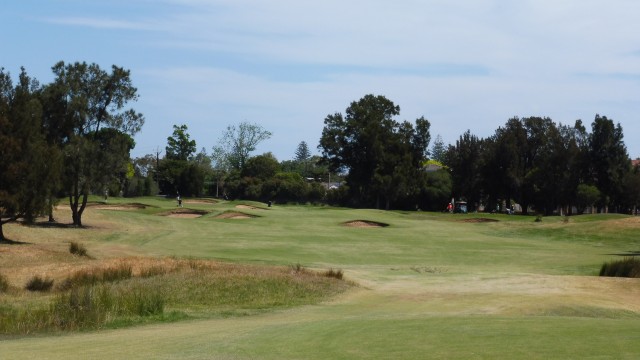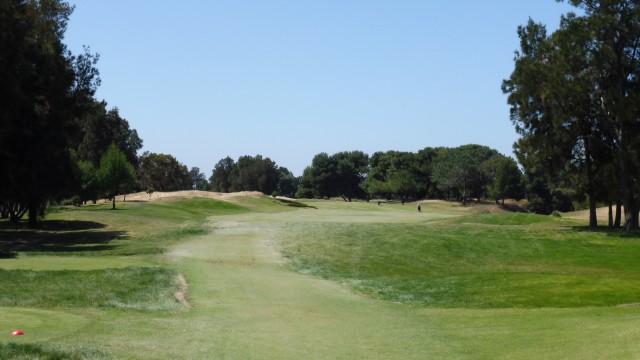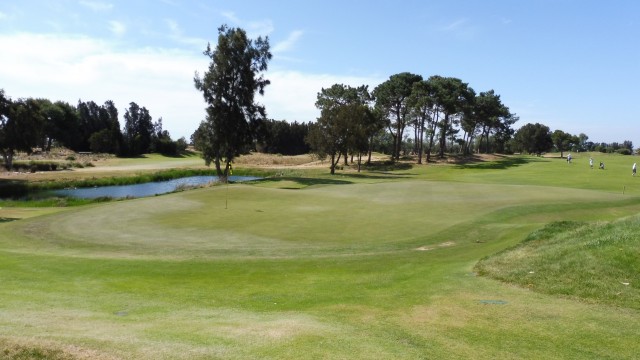
Location: Novar Gardens, SA
Established: 1927
Architect: H.L. Rymill (1927) / Vern Morcom (1955)/ Neil Crafter & Bob Tuohy (2004)
First Played: 27th Oct 2015
Last Played: 27th Oct 2015
Magazine Ratings

35 (Current)

43 (Current)
Going to Adelaide for a bucks night, I thought it essential to ensure I got a few games of golf in. Why waste a trip going interstate without finding a course or two you haven’t played. In this case I had yet to play any top 100 Australian golf courses in Adelaide, so took the opportunity to play all five, starting with Glenelg Golf Club.

Entrance to Glenelg Golf Club
Starting out in 1926, the club was formed, through a group of business men who originally would spend their Sundays travelling to the outskirts of the town, hacking their way through the wasteland. This then progressed to the need to purchase land and form a club, which was done by the end of 1926. The next year the course was opened and fully completed by 1928.

Clubhouse at Glenelg Golf Club
The first thing I was extremely impressed with at Glenelg Golf Club, was the friendliness of its members and staff. They went out of their way to make me feel welcome and enjoy the golfing experience. This was especially evident in the pro-shop, who were quite interested in my quest to play Australia’s Top 100 Courses.

Map of Glenelg Golf Club
The golf course has a links type base, but has plenty of trees lining the fairways. To me it is a mixture between parkland and links.

Glenelg Golf Club scorecard (Black Tee)
At first I was booked in to play alone, but the pro-shop staff did find a vacant spot among some members, which gave me the benefit of two things. Get a bit of local knowledge about the course, always helpful on your first visit, but also enter the local competition of the day, plus some side bets. My playing partners for the day were John, Peter and BJ.

Hole 1 -293 meter par 4
A nice hole to start with being the shortest and easiest par 4 on the course. The hole plays with a slight turn to the left, with water down this side for those with first tee jitters, but a wide fairway to hit.

Approach from the 1st fairway
One thing that stood out making the approach to the first green, was the face of the bunkers. These were quite steep, so not the best place to end up.

Hole 2 – 392 meter par 4
After being eased into the round, you cop a hard slap straight away with the hardest hole on course, which is the longest par 4. The hole plays with a slight dogleg to the left. From the tee bunkers are in play on the right, with the possibility of running through the fairway for longer hitters, but out of bounds is down the left.

Looking across to the 2nd Green
Hitting into the second, the next think I learnt was that bump and run was the way to go on or around the greens. Quite firm with a swale or two in the runoff areas. Two traps were protecting the either side of the green, but a clear area allows the ball to be run in.

Hole 3 – 178 meter par 3
Next is the longest par 3 on the course at a nice 200 meters. Traps run down most of the right side with a lonely one left. I was advised best to miss short left or long. Right won’t be pretty, nor too long straight.

Long, well protected 3rd green
I really liked this green complex. Plenty of variation from different areas around the green with traps (grass and sand) and varying undulations. The putting surface is longer than it is wide. I found myself missing on the wrong side, with the ground quite firm, making for an interesting shot across this narrow green.

Hole 4 – 285 meter par 4
Short par 4 offering risk and reward. With a slight turn to the left, it is possible to take a tighter line to the green, but bring many bunkers into play. Play safe to the middle or right, which leaves a clear line in.

Among the bunkers heading to the 4th Green
Being slightly out with the tee shot means the potential of landing in one of five bunkers. The green is angled to allow an easier shot from the right and has gentle slopes to contend with. Depending on the wind the hole has a lot of diversity in how you play.

Hole 5 – 455 meter par 5
Getting to the longest par 5 on the course, from the tee you need to land between a group of mounds and the water hazard on the right, which some smaller mounds on this side manage to block from view.

Multi-tiered 5th Green
Some fairway bunkers are located in the middle of the fairway within 100 meters of the green. The green is multi tiered, requiring an accurate tee shot. This hole is mostly about landing the shot on the fairway and staying out of trouble.

Hole 6 – 384 meter par 4
A long par four with a dogleg left is next up. It is possible to cut the corner, but drive too long and the fairway bunkers will be waiting for you. There is the accidental pull on to the next fairway which will significantly shorten the hole, but there is a sign saying do not do this.

Well protected 6th Green
The green is well guarded on either side, but one smart thing is the bunker around 30 meters short on the left. To run the ball in this must be carried. The putting surface itself is quite large, which it should be for a long two shot hole. The pin can be tucked in at the back right, allowing the traps to give some protection.

Hole 7 – 370 meter par 4
Having a dogleg right was the first change of direction for the par 4 holes. Until now they had all been to the left. Three traps line the right side of the fairway, which can be carried by long hitters. End up short and you will be scrambling the rest of the way. Ample room is available to the left to play safe.

Trying to take a short cut to the 7th green
Still left with a decent shot to the green, if you managed to carry the fairway traps, you may end up in the firm rough area, with the trap on the right, potentially having to be carried.

Hole 8 – 370 meter par 4
Interesting tee shot involved, with a small carry over water, but more a case on how much you take close to or over the trees to gain a bit more distance, but also avoid going through the fairway and finding scrub, a bunker or even another water hazard. This hole doglegs to the right rather quickly, so it is important to get the right direction from the tee.

Playing uphill to the 8th Green
Finding the fairway doesn’t mean it is all downhill, in fact it is uphill slightly to the green. Two large traps are on the left, with a solitary green bunker to the right. Lots of undulation on and around the putting surface to contend with. Tough hole leaving you satisfied if you par.

Hole 9 – 343 meter par 4
Finishing out the front, is a mid length par 4. From the tee you must hit slightly left of center as the fairway slopes this way. Too far left brings one bunker into play before reaching a bit of down slope.

Avoid the bunker on the 9th Fairway
The hole plays fairly straight, but finding either of the fairway traps leaves a long sand approach, which is unlikely to make the distance.

Looking back from the 9th Green
The green itself has bunkers and water to the right or a large grassy mound to the left. Quite a long putting surface with a few mounds and undulations to avoid.


Tee markers and pin flags at Glenelg Golf Club
Ending the first nine takes you close to the clubhouse, but more the carpark. Make sure you stock up on liquid or refreshments before starting the round. Plenty of water stations are found throughout the course however.

Hole 10 – 350 meter par 4
Starting the back nine is a mid length par 4. The hole plays fairly straight and the green is unseen from the tee. Hitting at the smaller tree tops in the distance is the ideal target. Going to the right brings a few fairway traps into play.

Down hill shot to the 10th Green
Once you reach the top of the hill on the fairway, it is down all the way to the green. Traps front and rear are ready for any shot not straight at the middle. The two tiered green is quite large. Quite scenic making the approach shot.

Looking back from the 10th Green
Two very difficult pin positions can be found on the 10th green. Back right or back left.

Hole 11 – 149 meter par 3
Not the longest, but ranked as the hardest par 3, this mid length hole plays up a deceiving slope. Most of the ground runs to the right, where plenty of bunkers can be found.

Bunkering along the 11th green
The bunker on the right almost runs the entire length of the putting green. There are also two swales on the left, which look to be filled in bunkers. These make playing in from a shot too far left, a lot more trickier, as the green is not overly wide.

Hole 12 – 435 meter par 5
The shortest par five is also the easiest hole on the course. With a dogleg to the right, this plays from an extremely elevated tee, allowing for aggressive tee shots for long hitters to carry the trees.

The concealed 12th Green
Making the approach to the green can almost be a blind shot, as the green sits slightly hidden behind a large bunker and between two mounds. Lots of small undulations are found around the outskirts.

Deceiving slopes on the 12th Green
But it is the gentle contours which are quite tricky to read on the putting surface which you should be more aware of. I quite liked this hole, as it was deceiving around the green acting as a defence, given its small distance for a five shot hole.

Hole 13 – 332 meter par 4
A mid length hole with a dogleg to the right. Playing into a strong headwind made this hole seem a lot longer. Trees line the right, along with a couple of fairway traps.

Trouble surrounds the 13th Green
A green which has trouble either side, one more penal than the other. On the left, water, with one trap which might save you going into it. The right has a large mound covered in longer grass, with two traps at its base. No these could be very unfortunate to land in, especially for people who aren’t strong bunker players, as the water awaits for any shot not hit quite right. The putting surface itself has two tiers and I can attest that the surface does not slope towards the water.

Hole 14 – 147 meter par 3
The remaining par 3 holes are both very scenic, requiring a water carry. There is no way to get around this carry, the alternate is hitting through the heavy grass, which will not get you far.

Deceptive bunker short of the 14th Green
Traps are located on either side of the green, but the more interesting one is slightly short, leaving a small valley between this and the green. This has the ability to deceive the distance from the tee shot, but also stop the ball from being run up to the green, especially during strong wind conditions.

Hole 15 – 328 meter par 4
From the tee, this short par 4 has bunkers lining either side of the landing area of the fairway, although more heavily to the right side covering the dogleg to the green.

Raised bunkerless 15th Green
One of the few greens on the course to not have any bunkers surrounding. Rather this has an elevated section to the green separated from the fairway with heavy rough.

Hole 16 – 117 meter par 3
The last par 3 for the day is the shortest hole on the course. There are quite a few different tee positions available for this hole, all changing how the hole is viewed and played. From the back tee, where the above photo was taken, the hole measures 20 meters longer, and has a totally different angle. The white tee was from the right of the above picture, requiring all carry to reach the green.

Playing parnter John beside the 16th Green
You can afford to go left or long on this hole (white tee) but anything short or right will find a watery grave. The front has a bunker, whilst the rear has some slope away from the putting surface.

Hole 17 – 355 meter par 4
The penultimate hole is a mid length par 4 with a dogleg left, around a water hazard. A bunker also sits on the inside of the dogleg, with the best line being over this or just to the left. Large trees will block any shot short of the bunker, from going directly at the green.

Approach from the 17th Fairway
The fairway leading in to the green narrows dramatically, with trees to the right and some large mounds to the left. This is visually deceptive as there is still quite a bit of room to make the approach, or land short if required.

Bunker protects the 17th Green
The 17th green is very wide, with a large bunker protecting the front. Hitting this and staying on in two is an achievement, especially in the afternoon wind.

Hole 18 – 477 meter par 5
The last has a large fairway to land on, but can play tricks on the mind. Trees line the left for most of the way, hiding the boundary fence, whilst a large waster hazard is to the left. Aiming just right of the fairway bunker is ideal.

Looking at the 18th Green from the clubhouse
Coming in to the 18th green there are numerous fairway traps to the right, in front of the clubhouse. If aiming for the green on the second shot, consideration must be made for the water hazard to the left. This green has large undulations and a false front.
In summary there are so many things to say. First of all the customer service, not something I bring up a lot, but they were exceptional. In my top 10 so far on this journey. I really felt welcome to the club and helped to enhance the experience. Now for the course, the condition was close to excellent. A couple of areas being worked on, but nothing which caused issues. Fairways were firm and fast, as well as the greens and their surrounds. I was impressed with the bunkering systems, luckily I was rarely in them. There was a good mixture in the lengths of holes, but the number of hole turning left vs right, was quite a big difference. I also found the front nine had good change in compass direction of the holes, but the back nine seemed to be more in the one direction.
Of the five courses I played for the week I would have rated this 4th. I would not hesitate to play here again, but I would be more likely to play Royal Adelaide Golf Club or Kooyonga Golf Club before returning.
How to play at Glenelg Golf Club:
1. Be invited by a member
2. Be an interstate or overseas visitor who is a member of a golf club

